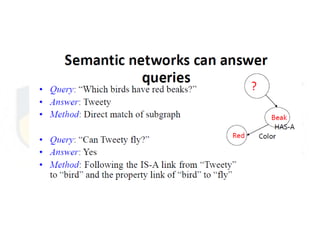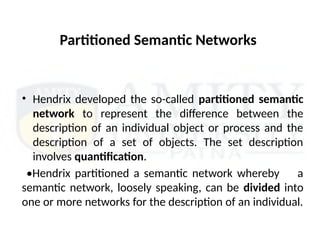Knowledge Representation : Semantic Networks
- 1. Knowledge Representation Lalita Kumari Associate Professor ASET Amity University, Patna
- 2. Type of Knowledge Structure • Weak Slot - Filler Structure –Semantic Nets –Frame •Strong Slot - Filler Structure –Scripts –Conceptual Dependency
- 3. 3 Semantic Networks • Structured representations (semantic networks and frame systems) – Put structures into KB (capture the interrelations between pieces of knowledge – Centers around object/classes – Emphasis is on what it is than what to do • History of semantic networks (Quillian, 1968) – To represent semantics of natural language words by dictionary-like definitions in a graphic form – Defining the meaning of a word in terms of its relations with other words (associations between terms) – Semantic networks were very popular in the 60’s and 70’s – The graphical depiction associated with a semantic network is a big reason for their popularity. – Also called associative networks
- 4. Semantic Nets •Semantic network or a semantic net is a structure for representing knowledge as a pattern of interconnected nodes and arcs. •It is also representation of knowledge. •Node in the semantic net represent either –Entities, –Attributes, –State or Events. •Arcs in the net give the relationship between the nodes. •Labels on the arc specify what type of relationship actually exits.
- 5. 5 Nodes and Arcs • Nodes denote objects/classes • arcs define binary relationships between objects. john 5 Sue age mother mother(john,sue) age(john,5) wife(sue,max) age(sue,34) ... 34 age father Max wife husband age
- 6. 6 Multiple inheritance • A node can have any number of superclasses that contain it, enabling a node to inherit properties from multiple "parent" nodes and their ancestors in the network. • Conflict or inconsistent properties can be inherited from different ancestors • Rules are used to determine inheritance in such "tangled" networks where multiple inheritance is allowed: – if X A B and both A and B have property P (possibly with different variable instantiations), then X inherits A’s property P instance (closer ancestors override far away ones). – If X A and X B but neither A B nor B A and both A and B have property P with different and inconsistent values, then X will not inherit property P at all; or X will present both instances of P (from A and B) to the user
- 7. 7 Exceptions in ISA hierarchy • Properties of a class are often default in nature (there are exceptions to these associations for some subclasses/instances) • Closer ancestors (more specific) overriding far way ones (more general) • Use explicit inhibition links to prevent inheriting some properties isa isa Bob Human Mammal isa isa Tweedy penguin bird 2 has-legs 4 has-legs Fly can-do Inhibition link
- 8. Example: Semantic networks… •“A sparrow is a bird” –Two concepts: “sparrow” and “bird” – sparrow is a kind of bird, so connect the two concepts with a IS-A relation This is an higher-lower relation or abstract- concrete relation • Bird
- 11. •Tweety and Sweety are birds •Tweety has a red beak •Sweety is Tweety‟s child •A crow is a bird •Birds can fly •Sparrow is a bird. •Sparrow has a wing.
- 13. Example: Semantic Networks.. • Scooter is a two wheeler. •Motor-bike is a two wheeler. •Motor-bike is a moving-vehicle. •Moving –vehicle has engine. •Moving-vehicle has electrical system. •Moving-vehicle has fuel system
- 19. Represent following information in Semantic net •(is_a circus-elephant elephant) •(has elephant head) •(has elephant trunk) •(has head mouth) •(is_a elephant animal) •(has animal heart) •(is_a circus-elephant performer) •(has performer costumes)
- 21. Partitioned Semantic Networks • Hendrix developed the so-called partitioned semantic network to represent the difference between the description of an individual object or process and the description of a set of objects. The set description involves quantification. •Hendrix partitioned a semantic network whereby a semantic network, loosely speaking, can be divided into one or more networks for the description of an individual.
- 22. Partitioned Semantic Networks • The central idea of partitioning is to allow groups, nodes and arcs to be bundled together into units called spaces – fundamental entities in partitioned networks, on the same level as nodes and arcs (Hendrix). • Every node and every arc of a network belongs to (or lies in/on) one or more spaces. • Some spaces are used to encode 'background information' or generic relations; others are used to deal with specifics called 'scratch' space.
- 23. • Suppose that we wish to make a specific statement about a dog, Danny, who has bitten a postman, Peter: • –" Danny the dog bit Peter the postman“ • Hendrix’s Partitioned network would express this statement as an ordinary semantic network:
- 24. • Suppose that we now want to look at the statement: • – "Every dog has bitten a postman" • Hendrix partitioned semantic network now comprises two partitions SA and S1. Node G is an instance of the special class of general statements about the world comprising link statement, form, and one universal quantifier
- 25. Advantages of semantic networks • –Simple representation, easy to read • –Associations possible • –Inheritance possible Disadvantages of semantic networks • –A separate inference procedure (interpreter) must be build • –The validity of the inferences is not guaranteed • –For large networks the processing is inefficient
- 26. Exercises • Try to represent the following two sentences into the appropriate semantic network diagram: • –"John believes that pizza is tasty" • –"Every student loves to party“ • –John gave Mary the book


























